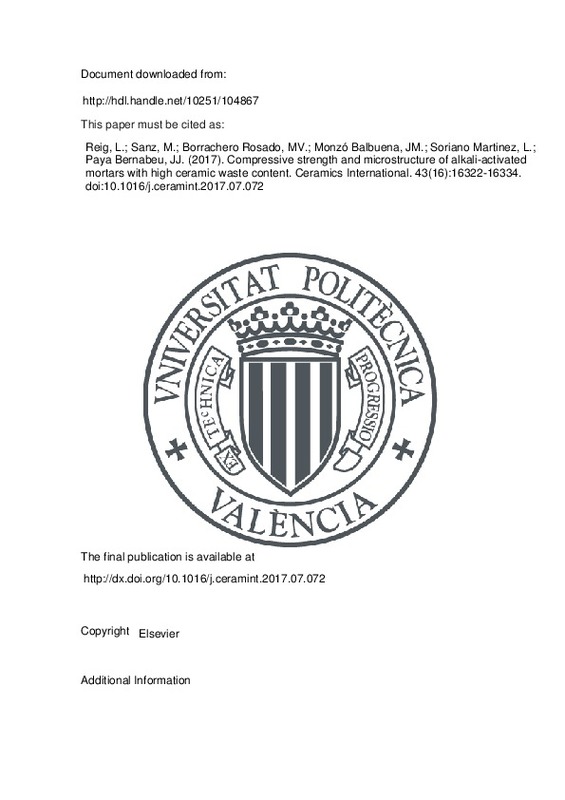JavaScript is disabled for your browser. Some features of this site may not work without it.
Buscar en RiuNet
Listar
Mi cuenta
Estadísticas
Ayuda RiuNet
Admin. UPV
Compressive strength and microstructure of alkali-activated mortars with high ceramic waste content
Mostrar el registro sencillo del ítem
Ficheros en el ítem
| dc.contributor.author | Reig, L.
|
es_ES |
| dc.contributor.author | Sanz, M.A.
|
es_ES |
| dc.contributor.author | Borrachero Rosado, María Victoria
|
es_ES |
| dc.contributor.author | Monzó Balbuena, José Mª
|
es_ES |
| dc.contributor.author | Soriano Martínez, Lourdes
|
es_ES |
| dc.contributor.author | Paya Bernabeu, Jorge Juan
|
es_ES |
| dc.date.accessioned | 2018-06-30T04:24:16Z | |
| dc.date.available | 2018-06-30T04:24:16Z | |
| dc.date.issued | 2017 | es_ES |
| dc.identifier.issn | 0272-8842 | es_ES |
| dc.identifier.uri | http://hdl.handle.net/10251/104867 | |
| dc.description.abstract | [EN] The present work investigated alkali-activated mortars with high ceramic waste contents. Tile ceramic waste (TCW) was used as both a recycled aggregate (TCWA) and a precursor (TCWP) to obtain a binding matrix by the alkali-activation process. Mortars with natural siliceous (quartz) and calcareous (limestone) aggregates, and with other ceramic waste materials (red clay brick RCB and ceramic sanitaryware CSW waste), were also prepared for comparison purposes. Given the lower density and higher water absorption values of the ceramic aggregates, compared to the natural ones, it was necessary to adapt the preparation process of the recycled mortars by presaturating the aggregate with water before mixing with the TCWP alkali-activated paste. Aggregate type considerably determined the mechanical behaviour of the samples cured at 65 °C for 3 days. The mortars prepared with the siliceous aggregate presented poor mechanical properties, even when cured at 65 °C. The behaviour of the limestone aggregate mortars depended heavily on the applied curing temperature and, although they presented the best mechanical properties of all those cured at room temperature, their compressive strength reached a maximum when cured at 65 °C, and then decreased. The mechanical properties of the mortars prepared with TCWA progressively increased with curing time (53 MPa at 65 °C for 28 days). An optimum 50 wt% proportion was observed for the limestone/TCWA mortars (¿43 MPa, 3 days at 65 °C), whereas the mechanical properties of that prepared with siliceous particles (10 MPa) progressively increased with the TCWA content, up to 100 wt% substitution (23 MPa). Limestone particles interacted with the binding matrix, and played an interesting beneficial role at the 20 °C curing temperature, with a slight reduction when cured long term (28 days) at 65 °C. The results demonstrated a potential added value for these ceramic waste materials. | es_ES |
| dc.description.sponsorship | The authors would like to thank the Spanish Ministry of Science and Innovation and the Spanish Ministry of Economy and Competitiveness for supporting this study through Projects GEOCEDEM BIA 2011-26947 and BIA2015 70107-R, respectively. They also thank FEDER funding. | |
| dc.language | Inglés | es_ES |
| dc.publisher | Elsevier | es_ES |
| dc.relation.ispartof | Ceramics International | es_ES |
| dc.rights | Reconocimiento - No comercial - Sin obra derivada (by-nc-nd) | es_ES |
| dc.subject | Strength (C) | es_ES |
| dc.subject | Alkali activation | es_ES |
| dc.subject | Tile ceramic waste | es_ES |
| dc.subject | Recycled aggregate | es_ES |
| dc.subject.classification | INGENIERIA DE LA CONSTRUCCION | es_ES |
| dc.title | Compressive strength and microstructure of alkali-activated mortars with high ceramic waste content | es_ES |
| dc.type | Artículo | es_ES |
| dc.identifier.doi | 10.1016/j.ceramint.2017.07.072 | es_ES |
| dc.relation.projectID | info:eu-repo/grantAgreement/MINECO//BIA2015-70107-R/ES/APLICACIONES DE SISTEMAS GEOPOLIMERICOS OBTENIDOS A PARTIR DE MEZCLAS DE RESIDUOS: MORTEROS,HORMIGONES Y ESTABILIZACION DE SUELOS/ | es_ES |
| dc.relation.projectID | info:eu-repo/grantAgreement/MICINN//BIA2011-26947/ES/REUTILIZACION DE RESIDUOS CERAMICOS Y DE DEMOLICION EN LA PREPARACION DE NUEVOS MATERIALES GEOPOLIMERICOS/ | es_ES |
| dc.rights.accessRights | Abierto | es_ES |
| dc.contributor.affiliation | Universitat Politècnica de València. Departamento de Ingeniería de la Construcción y de Proyectos de Ingeniería Civil - Departament d'Enginyeria de la Construcció i de Projectes d'Enginyeria Civil | es_ES |
| dc.contributor.affiliation | Universitat Politècnica de València. Instituto de Ciencia y Tecnología del Hormigón - Institut de Ciència i Tecnologia del Formigó | es_ES |
| dc.description.bibliographicCitation | Reig, L.; Sanz, M.; Borrachero Rosado, MV.; Monzó Balbuena, JM.; Soriano Martínez, L.; Paya Bernabeu, JJ. (2017). Compressive strength and microstructure of alkali-activated mortars with high ceramic waste content. Ceramics International. 43(16):16322-16334. https://doi.org/10.1016/j.ceramint.2017.07.072 | es_ES |
| dc.description.accrualMethod | S | es_ES |
| dc.relation.publisherversion | http://dx.doi.org/10.1016/j.ceramint.2017.07.072 | es_ES |
| dc.description.upvformatpinicio | 16322 | es_ES |
| dc.description.upvformatpfin | 16334 | es_ES |
| dc.type.version | info:eu-repo/semantics/publishedVersion | es_ES |
| dc.description.volume | 43 | es_ES |
| dc.description.issue | 16 | es_ES |
| dc.relation.pasarela | S\356407 | es_ES |
| dc.contributor.funder | Ministerio de Ciencia e Innovación | es_ES |







![[Cerrado]](/themes/UPV/images/candado.png)

